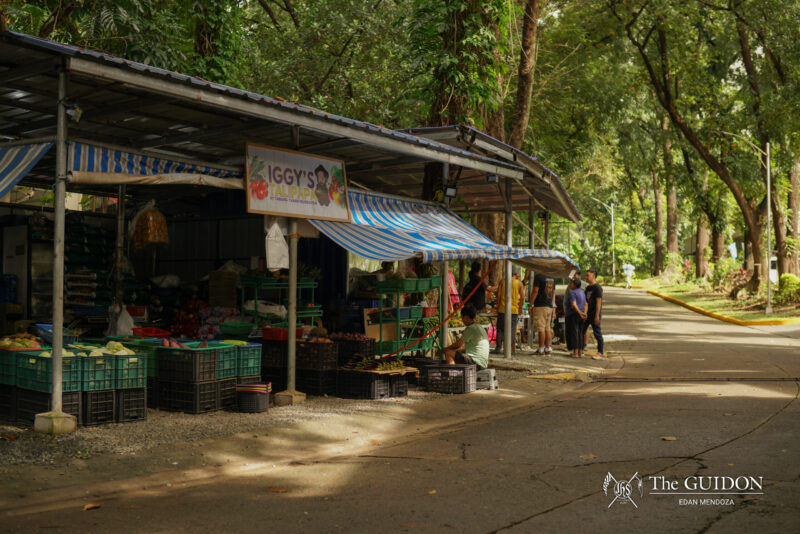As carols chime and lights glisten, assisting us in our holiday preparations are hands forced to continuously work for their very own perfect Christmas.
MALLING HAS grown to become a staple in the urban Filipino lifestyle. For their annual holiday shopping, thousands of people in Metro Manila flock to popular malls, such as SM City North EDSA in Quezon City. Illuminated by red and green lights, the 425,000-square-meter establishment is the country’s second-largest mall and the first SM mall to have ever existed.
While consumers rush to purchase the items on their lengthy wishlists, some grapple to make ends meet. To afford spending a humble celebration with their loved ones, mall employees work extended hours during the holiday season, simultaneously tending to both consumers’ needs and their financial necessities.
Christmas rush
Ate Hazel* is a sales advisor at the SM City North EDSA branch of a multinational clothing company. On a regular work day, her tasks range from general customer service to taking over the counter. She usually keeps herself busy in the fitting room by folding clothes discarded by the customers and attending to their other requests.
During the holidays however, crowds bombard every inch of the store, making the area more disorganized. The Christmas rush also entails longer working hours—for instance, Ate Hazel works from 2 PM to 12 AM during this season.
Often ending her days exhausted, Ate Hazel credits her eight years of experience in the retail industry as her training to withstand the heavy demands of the holiday rush.
Another employee working the graveyard shift during the holidays is Kuya Marco*, a service crew worker in one of the food court stalls. He greets customers with a smile on his face and an attentive look in his eyes. Despite only working in the stall for eight months, the 28-year-old has already been in the food service industry for ten years.
During peak season, he goes four hours over his usual schedule as constant streams of people line up to purchase food. “Nagbebenta po kami sa 50–60 na tao. ‘Pag Pasko po, isipin po limang beses po na gan’on,” Kuya Marco shares.
(We get to sell to about 50-60 people. During Christmas, it’s about five times more than that.)
Like Ate Hazel, Kuya Marco handles numerous tasks at once. As an all-rounder, he categorizes the stocks of ingredients and supplies, maintains sanitation, cooks food, and keeps track of the products sold.
However, no amount of hard work compensates for the far-from-ideal conditions faced by mall employees.
Hustle and bustle
Amid the occupational stress that is part and parcel with their jobs, earning money for their families has been a main motivator for Ate Hazel and Kuya Marco to persevere.
On the 25th of December and the 1st of January, Ate Hazel chooses to go to work. She decides to take a leave on the 24th and the 31st of December instead. Her family is the driving force behind such choices, as she enjoys cooking Noche Buena and Media Noche meals for the holiday season.
Another reason that compels her to work during the season is receiving greater incentives. “Binibigyan naman kami ng chance na [pumili] kung kailan ninyo gusto mag-rest day, like Christmas ba or New Year. […] Kaso minsan kasi, siyempre holiday, [so] double pay,” she shares.
(We are given the chance to pick when we want to have our rest day, whether that would be during Christmas or New Year. […] But since these are holidays, we are given double pay.)
On the other hand, Kuya Marco celebrates the holidays with his live-in partner. With the necessity of working hard to afford gifts and pay bills, his economic condition led him to label himself as an “alipin ng salapi” or a slave of money. Thus, he continues to work in sickness and in health.
“Kung wala kang trabaho, wala kang kakainin eh, lalo na’t sa panahon na napakataas na ng bilihin (If you don’t have a job, you won’t have anything to eat, especially in a time when prices for basic needs are so high),” Kuya Marco grieves.
Overworked and underpaid, Kuya Marco concedes that this is how it has always been.
Christmas and consumerism
Ate Hazel and Kuya Marco believe that the Filipino culture has ingrained the practice of smiling through the challenges they face—to grit their teeth, to deal with it, and to love through sacrifice.
However, consumerism has become intertwined with the spirit of Christmas, subduing mall workers to continually labor for the sake of receiving the bare minimum compensation.
Numerous laborers have shared sentiments of struggle similar to those of Ate Hazel and Kuya Marco. Throughout the years, labor unions have continuously advocated for higher pay during the Christmas season and a higher minimum wage in general.
For consumers and mall employees alike, Christmas is a supposed time of rest and reflection with their loved ones—but in a society troubled with many economic concerns, completely enjoying the season has become a privilege.
Without improvements to working conditions, the likes of Ate Hazel and Kuya Marco have no choice but to persevere. Amid the holiday rush, they resume hoping that the future of their families shines brighter than the dull Christmas city lights holding nothing but empty promise.
*Editor’s Note: The interviewees’ names have been changed at their request to protect their identity and privacy.







